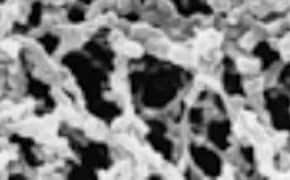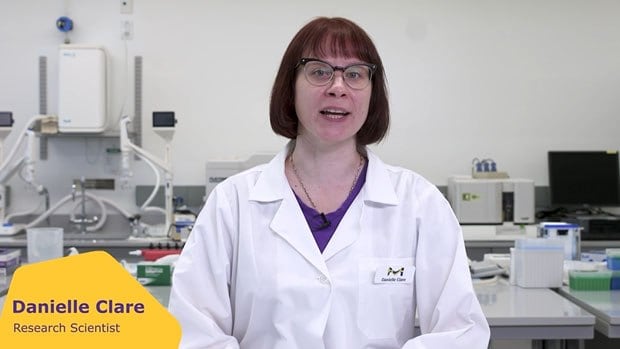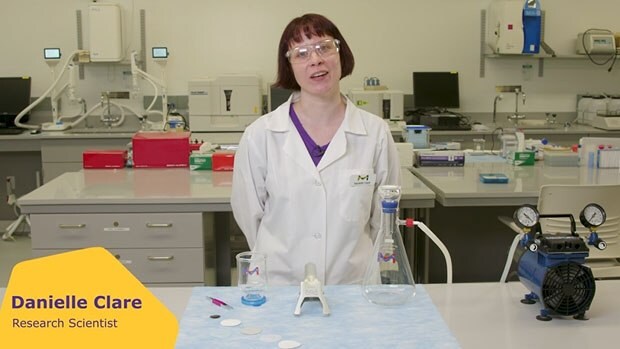Filter Membranes

Produced by the precipitation or stretching of polymeric materials, membrane filters are commonly used in both industry and research. Properties of membrane filters vary widely with differences in composition, surface treatments, and pore size. Selecting the ideal filter requires an understanding of basic characteristics. We offer an extensive collection of Millipore® and Whatman™ membranes for filtration.
Products
Compare
Product Number
Product Name
Product Description
Pricing
Membrane Filter Characteristics
- Chemical compatibility: The filter material must be compatible with the chemical nature of both the liquid and dissolved solutes being filtered to avoid structural failure.
- Wettability: Hydrophilic membranes are easily wet with water and are preferred for filtering aqueous solutions. Hydrophobic membranes are recommended for gas filtration, low surface tension solvents, and venting, and can be wet in organic solvents such as methanol, allowing both aqueous liquids and organic solvents to pass through.
- Pore Size: Pore size provides an indication of largest pore diameter and can be related to the membrane’s ability to filter out particles of a certain size.
- 0.1 µm: mycoplasma removal
- o 0.20 to 0.22 µm: filter sterilization and ultracleaning of aqueous solutions and organic solvents (e.g., HPLC)
- 0.45 µm: clarification of aqueous solutions and organic solvents
- 0.8 µm: coarse particulate removal and removal of bacteria
- 100 µm: removal of sand, activated carbon, bead resins
- Diameter: The diameter, size, and shape of the filter are selected based on the apparatus used for filtration. Disc filters, syringe filters, extractors, and bottle top filtration devices have specified diameters for membrane filters.
- Flow rate: Defined as the time required for the flow stream to pass through the filter, flow rate is critical in determining how rapidly a filtration can be completed. Membrane material, thickness, porosity, and pore architecture can all lead to differences in flow rate.
- Optical properties: When visually analyzing retentates, membrane optical properties must be compatible with the imaging method in order to provide a consistent background and reduce noise.
- Color: Filter color selection can provide appropriate contrast for easy and reliable identification and quantitation. Black filters provide distinction between light colored particles and microorganisms. White filters provide distinction between blue, red, and darker microbes and particulates. Green filters offer a background for viewing black, white, and colorless particles.
- Binders: Commonly used in non-woven, fiber-based materials, binders provide shape and strength to the final product.
- Organic binders provide higher wet strength and lower fiber release for high pressure filtration.
- Inorganic binders impart high thermal and chemical stability and inertness to microbiological degradation compared to organic binders.
- Cellulose acetate membranes are ideal for biological and clinical analysis, sterility tests, and scintillation measurements. They exhibit very low protein binding affinity and are recommended for low protein binding applications. Solvent- and heat-resistant up to 180 ºC, these membrnaes are suitable for the filtration of either aqueous cell culture and alcoholic media.
- Cellulose nitrate membranes are recommended for general filtration applications including buffer filtration and feature low extractable levels and a narrow pore size distribution. While nitrocellulose is often considered to be brittle and thermally instable, these filters offer increased strength and flexibility as well as thermal stability up to 121 °C, allowing them to be autoclaved without shrinkage or integrity loss. Cellulose nitrate membrane filters feature high protein binding, which may result in sample loss when filtering biological samples.
- Mixed cellulose ester (MCE) membrane filters are composed of both cellulose acetate and cellulose nitrate and are biologically inert, low binding, and thermally stable with a high loading capacity, making them an ideal choice for a variety of filtration applications including aqueous solution clarification, particle counting, HPLC sample filtration, and microbial analysis. For applications requiring manual particulate or colony counting, a gridded surface and color contrast facilitates particle detection and minimizes eye fatigue.
- Polyethersulfone (PES) membranes are known for their thermal stability, durability, and resistance to acidic and alkaline solutions. Millipore Express® PLUS hydrophilic polyethersulfone (PES) membranes are commonly used as an alternative to cellulose membranes and offer fast flow, high filter capacity, and low protein binding while remaining bacterially retentive.
- Polytetrafluoroethylene (PTFE) membranes have high strength and broad chemical compatibility, and are commonly used to clarify aqueous solutions, organic solvents, corrosives, and aggressive fluids. Hydrophilic PTFE membranes are typically used in filtering aqueous solutions, while hydrophobic PTFE membranes are typically used for filtering organic solvents and gases as well as particle monitoring.
- Nylon and polyamide membranes offer broad compatibility, strength, flexibility, and hydrophilicity with low extractables, and are routinely used for the filtration of aqueous and organic solutions for use in HPLC and other analytical methods. They can exhibit high protein and small molecule binding and are not recommended for biological samples.
- PVDF membranes are utilized in a variety of biomedical research applications. Available in both hydrophilic and hydrophobic formats, Durapore® membrane filters provide high flow rates and throughput, low extractables, and broad chemical compatibility. Hydrophilic Durapore® membranes exhibit very low protein binding and are used to filter protein solutions. Conversely, hydrophobic Durapore® membranes exhibit high protein binding.
- Regenerated cellulose membranes are hydrophilic, spontaneously wet in water, and feature strong chemical resistance for filtering both aqueous and organic solutions. They are commonly used for filtering HPLC solvents and solutions. Regenerated cellulose membrane filters can be sterilized and have low protein binding and extractables, enabling their use with biological samples.
- Polycarbonate membrane filters are produced from a smooth, glass-like polycarbonate film and are recommended for all analyses in which the sample is viewed on the surface of the membrane, such as optical or electron microscopy. The unique membrane manufacturing process (track-etching) ensures a precise and consistent pore diameter for accurate sample separation by size. These membrane filters are commonly used in trace element and particulate analysis, gravimetric analysis, water analysis, and general filtration.
- Polypropylene membrane and net filters feature both solvent-compatibility and thermal stability. These filters are ideally suited for general solution clarification and prefiltration applications, including bioburden reduction. Millipore® polypropylene membrane and net filters provide high particle retention and dirt holding capacity, as well as a low pressure drop. While these filters are designed for use with organic solvents, they can also be used for the filtration of aqueous solutions, after wetting with an alcohol.
- Polyvinylidene chloride (PVC) filters are preferentially used with gravimetric analysis to quantify silica, carbon black, or quartz air particulates. Millipore® PVC membrane filters are produced from high-quality PVC and have been developed for use with ASTM, NIOSH, and OSHA air monitoring methods.
- Alumina oxide membrane filters are non-toxic and compatible with most solvents and aqueous solutions. The precise, nondeformable, honeycomb pore structure eliminates lateral crossover between pores, ensuring exact filter cut-offs and a narrow pore size distribution. These membrane filters exhibit low protein binding, have minimal autofluorescence, become virtually transparent when wet, and support cellular growth. Whatman™ Anodisc™ membrane filters are available with a bonded polypropylene support ring to allow for easier handling
- Glass fiber filters are produced from borosilicate glass fibers and are typically used as depth filters in prefiltration of large particulate or viscous solutions. The addition of binders can improve the wet strength for filtering heavily contaminated solutions but renders the filter unsuitable for gravimetric analysis or hot gas filtration due to mass loss upon heating. Glass fiber filters without a binder resin can be heated up to 500 °C without mass loss.
- Quartz fiber filters are manufactured from pure quartz fibers, preventing any surface filter reaction with acidic gases. Due to their inertness, quartz fiber filters are well suited for measuring heavy metal concentrations and small particle quantities. Quartz fiber filters also exhibit good weight and form stability and are commonly used in air sampling and trace element analysis.
- Silver membrane filters are ideal for applications involving aggressive fluids and/or high temperatures and are specified in National Institute for Occupational Safety and Health (NIOSH) standards for the analysis of crystalline and amorphous silica, lead sulfide, boron carbide, and chrysotile asbestos.
Filter Membrane Types
- Alumina oxide membrane filters are non-toxic and compatible with most solvents and aqueous solutions. The precise, nondeformable, honeycomb pore structure eliminates lateral crossover between pores, ensuring exact filter cut-offs and a narrow pore size distribution. These membrane filters exhibit low protein binding, have minimal autofluorescence, become virtually transparent when wet, and support cellular growth. Whatman™ Anodisc™ membrane filters are available with a bonded polypropylene support ring to allow for easier handling.**
- Cellulose acetate membranes are ideal for biological and clinical analysis, sterility tests, and scintillation measurements. They exhibit very low protein binding affinity and are recommended for low protein binding applications. Solvent- and heat-resistant up to 180 ºC, these membranes are suitable for the filtration of either aqueous cell culture and alcoholic media.
- Cellulose nitrate membranes are recommended for general filtration applications including buffer filtration and feature low extractable levels and a narrow pore size distribution. While nitrocellulose is often considered to be brittle and thermally instable, these filters offer increased strength and flexibility as well as thermal stability up to 121 °C, allowing them to be autoclaved without shrinkage or integrity loss. Cellulose nitrate membrane filters feature high protein binding, which may result in sample loss when filtering biological samples.
- Glass fiber filters are produced from borosilicate glass fibers and are typically used as depth filters in the prefiltration of large particulate or viscous solutions. The addition of binders can improve the wet strength for filtering heavily contaminated solutions but renders the filter unsuitable for gravimetric analysis or hot gas filtration due to mass loss upon heating. Glass fiber filters without a binder resin can be heated up to 500 °C without mass loss.**
- Mixed cellulose ester (MCE) membrane filters are composed of both cellulose acetate and cellulose nitrate and are biologically inert, low binding, and thermally stable with a high loading capacity, making them an ideal choice for a variety of filtration applications including aqueous solution clarification, particle counting, HPLC sample filtration, and microbial analysis. For applications requiring manual particulate or colony counting, a gridded surface and color contrast facilitates particle detection and minimizes eye fatigue.
- Nylon and polyamide membranes offer broad compatibility, strength, flexibility, and hydrophilicity with low extractables, and are routinely used for the filtration of aqueous and organic solutions for use in HPLC and other analytical methods. They can exhibit high protein and small molecule binding and are not recommended for biological samples.
- Polycarbonate membrane filters are produced from a smooth, glass-like polycarbonate film and are recommended for all analyses in which the sample is viewed on the surface of the membrane, such as optical or electron microscopy. The unique membrane manufacturing process (track-etching) ensures a precise and consistent pore diameter for accurate sample separation by size. These membrane filters are commonly used in trace element and particulate analysis, gravimetric analysis, water analysis, and general filtration.**
- Polyethersulfone (PES) membranes are known for their thermal stability, durability, and resistance to acidic and alkaline solutions. Millipore Express® PLUS hydrophilic polyethersulfone (PES) membranes are commonly used as an alternative to cellulose membranes and offer fast flow, high filter capacity, and low protein binding while remaining bacterially retentive.
- Polypropylene membrane and net filters feature both solvent-compatibility and thermal stability. These filters are ideally suited for general solution clarification and prefiltration applications, including bioburden reduction. Millipore® polypropylene membrane and net filters provide high particle retention and dirt holding capacity, as well as a low pressure drop. While these filters are designed for use with organic solvents, they can also be used for the filtration of aqueous solutions, after wetting with an alcohol.**
- Polytetrafluoroethylene (PTFE) membranes have high strength and broad chemical compatibility, and are commonly used to clarify aqueous solutions, organic solvents, corrosives, and aggressive fluids. Hydrophilic PTFE membranes are typically used in filtering aqueous solutions, while hydrophobic PTFE membranes are typically used for filtering organic solvents and gases as well as particle monitoring.
- Polyvinylidene chloride (PVC) filters are preferentially used with gravimetric analysis to quantify silica, carbon black, or quartz air particulates. Millipore® PVC membrane filters are produced from high-quality PVC and have been developed for use with ASTM, NIOSH, and OSHA air monitoring methods.**
- PVDF membranes are utilized in a variety of biomedical research applications. Available in both hydrophilic and hydrophobic formats, Durapore® membrane filters provide high flow rates and throughput, low extractables, and broad chemical compatibility. Hydrophilic Durapore® membranes exhibit very low protein binding and are used to filter protein solutions. Conversely, hydrophobic Durapore® membranes exhibit high protein binding.
- Quartz fiber filters are manufactured from pure quartz fibers, preventing any surface filter reaction with acidic gases. Due to their inertness, quartz fiber filters are well suited for measuring heavy metal concentrations and small particle quantities. Quartz fiber filters also exhibit good weight and form stability and are commonly used in air sampling and trace element analysis.**
- Regenerated cellulose membranes are hydrophilic, spontaneously wet in water, and feature strong chemical resistance for filtering both aqueous and organic solutions. They are commonly used for filtering HPLC solvents and solutions. Regenerated cellulose membrane filters can be sterilized and have low protein binding and extractables, enabling their use with biological samples.
- Silver membrane filters are ideal for applications involving aggressive fluids and/or high temperatures and are specified in National Institute for Occupational Safety and Health (NIOSH) standards for the analysis of crystalline and amorphous silica, lead sulfide, boron carbide, and chrysotile asbestos.
Related Resources
- Catalog: Filters and Supporting Hardware
Our exhaustive portfolio of fundamental filters and supporting hardware has helped generations of scientists reach new milestones.
Related Videos
Sign In To Continue
To continue reading please sign in or create an account.
Don't Have An Account?
